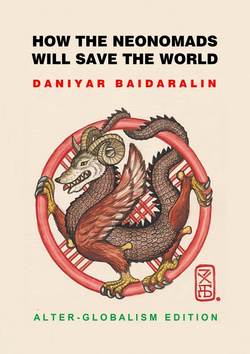Читать книгу How the Neonomads will save the world. Alter-globalism edition - Daniyar Z Baidaralin - Страница 8
THE CONCEPT: EURASIAN NOMADIC CIVILIZATION
Nomadic Transportation
ОглавлениеChariots and wagons
The Eurasian Nomads also made a revolution in transportation. Not many people today realize that the wheel was an EN invention. As we know from archaeological evidence, such as the Botai Culture in Central Kazakhstan and others, the early cattle-breeders didn’t ride horses. Horses were herded mostly for food or ritual purposes, because they were much smaller than modern-day horses and weren’t able to carry a rider. Therefore, to use them as transportation, the nomads had to invent pulled carts on wheels, which later led to a development of chariots and wagons. Chariots, in turn, evolved into feared war chariots, a trademark tech in most of the Ancient world.
Wheeled transports of the Eurasian Nomads: a wagon (left) and petroglyphs showing chariots (right)
This technological evolutions got spread all over the Afro-Euro Asian world of the Bronze Age by the early EN conquerors, such as Cimmerians and others. Horses and chariots were widely adopted by the settled nations of the Middle East, Egypt, Greeks and Romans, Persians, Indians, and Chinese. Having more resources and production power, these settled civilizations learned to mass-produce the chariots and created large armies reinforced with chariot units.
Wheeled wagons formed military wagon-trains that took loads from shoulders of SC foot-soldiers, and allowed for more provisions to be taken in campaigns. This made army marches to go much faster and cover longer distances. This explains the raise of the SC conquerors and formation of early SC empires of Antiquity.
Ascent of Centaurs
But the EN once again showed their ingenuity and persistence: they gradually bred larger horses and learned to mount them, resulting in a brand new phenomenon – a horseback rider. At last, the true Eurasian nomad was born. Now a person could ride for longer distances and be more swift and maneuverable, and pass through terrains not suitable for wheeled chariots and wagons.
Soon enough the military use of horsemen followed, and warriors on horses outperformed the charioteers. Both horseback archers and heavily-armored shock cavalry were more deadly and efficient than chariot archers and warriors. Also, a soft leather saddle and harness of early design cost a few orders of gratitude less than very expensive chariots. Gradually the wheeled combat vehicles went extinct in the Steppe, giving place to mighty Centaurs: people so comfortable riding horses that they seemed to be one creature.
An ancient depiction of the Scythian horseback archer
Of course the SC followed the suit and developed their own cavalry. This was a true arms race: everything the EN developed to win in wars against the overwhelming nations of the SC Rim, the later adopted after a while and started using against the nomads and each other. At this, the SC nations always enjoyed larger resource bases and virtually limitless amounts of recruits, whilst the nomads always had scarce numbers and resources and had to rely on their wits and skills.
So the Eurasian Nomads stroke again by developing a system where each horseback warrior took a few extra horses with him or her. This allowed the horsemen to change horses without stopping to rest them, so now they could cover long distances with great speed and hit enemies where they didn’t expect. Another words, the nomads used the advantage of having more horses that any SC nation in history: each nomadic family, even the poorest, possessed at least a half dozen horses, where the rich families had them in thousands. Therefore the EN could easily gather large and completely mounted armies in short time, a capacity that no settled nation could ever match, which gave them a long-lasting advantage.
Further evolution of wheeled transport
Arms races aside, the nomads also invented many interesting types of transportation for civilian usage. The wagons were one of them. The first wheeled carts were simply flat platforms on wheels pulled by horses or oxen. Then the nomads figured out that if they add some sort of roofing on top of a platform, it provides an additional protection from nature elements, as well as predators. The wagon is much more versatile and useful than the simple open cart.
Another absolutely amazing and ingenious invention of the EN was the yurt-cart: an actual fully furnished yurt being placed on top of a large, heavy, wheeled frame. The yurt-carts were of various shapes and sizes, ranging from early small livable wagons of the Bronze Age, to small and medium sized yurts on carts, and to large and luxurious Khan’s yurts on wheels during the so-called Mongol Empire that required dozens of oxen to pull them.
Clay models of Bronze Age’s livable wagons of Eurasia
Medieval yurt-cart of the so-called Mongols
Having a permanent home mounted on top of a moving cart was a big advantage for nomadic lifestyle. It saved time for putting/taking down yurts, and the nomads really valued their free time. Plus, it allowed for more comfortable moving conditions. Imagine entire cities of yurt-carts, many of which were beautifully decorated, moving slowly on the endless plains of the Great Steppe! That must have been quite a sight!
